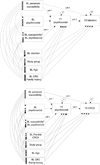Examining the role of perceived susceptibility on colorectal cancer screening intention and behavior
- PMID: 20658212
- PMCID: PMC3161120
- DOI: 10.1007/s12160-010-9215-3
Examining the role of perceived susceptibility on colorectal cancer screening intention and behavior
Abstract
Although support exists for multiple psychosocial predictors of colorectal cancer (CRC) screening, little is known about the relationships among these variables. Understanding the associations between such predictors could refine health behavior theories and inform the design of interventions. In addition to direct effects, we examined whether baseline perceived susceptibility was a moderator of, or was mediated by, changes in other psychosocial determinants of CRC screening intention and behavior. Longitudinal path models were tested using data from 1,001 white male automotive workers who participated in The Next Step Trial. Our sample included workers with no history of CRC who were due for CRC screening but did not complete CRC screening prior to the assessment of hypothesized mediators at year 1 follow-up. Perceived susceptibility interacted differently with four psychosocial constructs in models predicting CRC screening intention or behavior. Perceived susceptibility was independent of perceived benefits, moderated the change in perceived barriers and self-efficacy, and was mediated by the change in family influence. The role of perceived susceptibility was not limited to direct effects but involved mediating and moderating pathways of influence.
Figures

References
-
- American Cancer Society. Cancer facts and figures 2009. Atlanta, GA: American Cancer Society; 2009.
-
- Winawer SJ, Zauber AG, Ho MN, et al. Prevention of colorectal cancer by colonoscopic polypectomy. The National Polyp Study Workgroup. N Engl J Med. 1993;329:1977–1981. - PubMed
-
- Levin B, Lieberman DA, McFarland B, et al. Screening and surveillance for the early detection of colorectal cancer and adenomatous polyps, 2008: A joint guideline from the American Cancer Society, the US Multi-Society Task Force on Colorectal Cancer, and the American College of Radiology. CA Cancer J Clin. 2008;58:130–160. - PubMed
-
- U. S. Preventive Services Task Force. Screening for colorectal cancer: U.S. Preventive Task Force recommendation. Ann Intern Med. 2008;149:627–637. - PubMed
-
- Meissner HI, Breen NL, Klabunde CN, Vernon SW. Patterns of colorectal cancer screening uptake among men and women in the US. Cancer Epidemiol Biomarkers Prev. 2006;15:389–394. - PubMed

